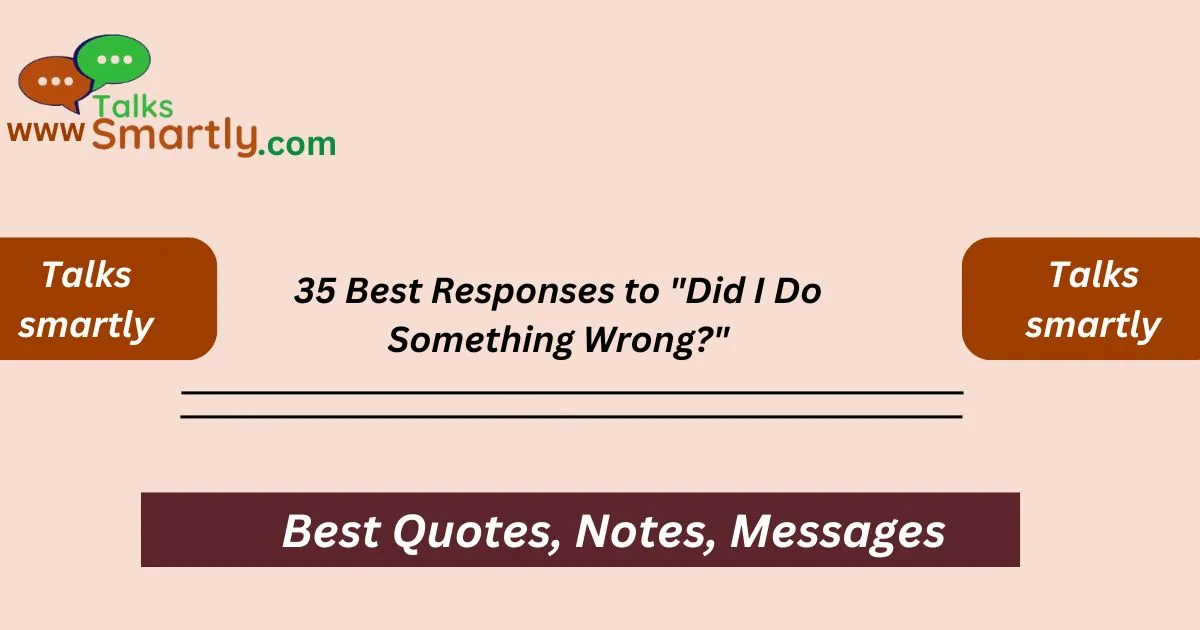“The right response to ‘Did I do something wrong?’ can create understanding and strengthen relationships.”
When someone asks, “Did I do something wrong?” it often signals a moment of vulnerability, curiosity, or even misunderstanding. How you respond can greatly impact the conversation, whether it’s to reassure them, address a mistake, or clarify a situation.
The right response can defuse tension, offer comfort, or open the door for an honest discussion. Whether you’re trying to be supportive, funny, or direct, crafting your reply carefully can help keep the interaction positive and productive.
In this guide, we’ll explore 35 of the best responses to “Did I do something wrong?” from heartfelt reassurances to light-hearted quips, tailored to various scenarios.
35 Best Responses to “Did I Do Something Wrong?”
- “Let’s talk about it, I value your perspective.”
- “I don’t think it’s about right or wrong, let’s understand each other better.”
- “No, you didn’t. But I think we should clarify a few things.”
- “I wouldn’t say you did something wrong, but I’d like to share how I felt.”
- “I appreciate your concern, let’s work through this together.”
- “I understand why you might feel that way, but everything is okay.”
- “It’s not about blame; let’s focus on how we can move forward.”
- “There’s nothing wrong, just a small misunderstanding.”
- “You didn’t do anything wrong, it’s more about how we can improve communication.”
- “It’s not that you did something wrong, it’s just a matter of perception.”
- “I wouldn’t say it was wrong, but there’s a better way to handle it next time.”
- “No worries, let’s just talk it out and clear up any confusion.”
- “I don’t think ‘wrong’ is the right word, let’s find a solution together.”
- “It’s not a big deal, let’s figure this out calmly.”
- “I don’t believe you did something wrong, let’s just adjust a bit.”
- “There’s no need to worry, we’re just working through a small issue.”
- “It’s not a matter of right or wrong, we just need to communicate better.”
- “You didn’t do anything wrong; let’s work together on how to improve.”
- “I think we’re just on different pages, not that you did something wrong.”
- “There’s no fault here, we just need to clarify a few things.”
- “I understand your concern, but there’s nothing to worry about.”
- “You didn’t do anything wrong, it’s just a learning opportunity.”
- “It’s more about understanding each other’s perspectives than being wrong.”
- “I appreciate your concern, but everything is fine. Let’s work through this.”
- “No harm done, let’s just communicate better moving forward.”
- “I don’t think you did anything wrong, let’s clear up the misunderstanding.”
- “There’s nothing wrong here, just a need for better communication.”
- “It’s not about right or wrong, it’s about learning and growing together.”
- “We’re just working through a challenge, not assigning blame.”
- “I wouldn’t say wrong, just a minor adjustment needed.”
- “You did nothing wrong, let’s just align better next time.”
- “No worries, let’s just focus on how to improve things moving forward.”
- “I don’t think it was wrong, just a different approach needed.”
- “It’s all part of learning; you didn’t do anything wrong.”
- “You didn’t do anything wrong, we just need to communicate more clearly.”
1. “Let’s talk about it, I value your perspective.”
This response emphasizes openness and encourages dialogue instead of jumping to conclusions.
Example: When a friend asks, “Did I do something wrong?” reply, “Let’s talk about it, I value your perspective,” to invite a calm discussion.
2. “I don’t think it’s about right or wrong, let’s understand each other better.”
This response focuses on understanding rather than assigning blame, leading to a constructive conversation.
Example: If a colleague asks this question, saying, “It’s not about right or wrong; let’s understand each other better,” helps defuse the tension.
3. “No, you didn’t. But I think we should clarify a few things.”
Offering clarification without assigning blame is a tactful way to handle potential misunderstandings.
Example: If your partner asks, “Did I do something wrong?” respond with, “No, but we should clarify a few things,” to avoid any lingering confusion.
4. “I wouldn’t say you did something wrong, but I’d like to share how I felt.”
This response focuses on feelings rather than accusations, promoting emotional honesty.
Example: When someone worries about their actions, responding with, “I wouldn’t say you did something wrong, but I’d like to share how I felt,” allows for a genuine conversation.
5. “I appreciate your concern, let’s work through this together.”

By appreciating their worry and suggesting teamwork, this response builds unity and problem-solving.
Example: If a co-worker expresses concern, reply with, “I appreciate your concern, let’s work through this together,” showing collaboration.
6. “I understand why you might feel that way, but everything is okay.”
This reassures the person while acknowledging their feelings, creating a sense of calm.
Example: If a friend asks if they did something wrong, saying, “I understand why you might feel that way, but everything is okay,” reassures them that no harm was done.
7. “It’s not about blame; let’s focus on how we can move forward.”
This response encourages moving past the issue instead of dwelling on guilt or blame.
Example: In a work setting, if someone asks this question, reply with, “It’s not about blame; let’s focus on how we can move forward,” to focus on solutions.
8. “There’s nothing wrong, just a small misunderstanding.”
Minimizing the issue without dismissing it shows sensitivity while calming the other person.
Example: When a family member feels they’ve made a mistake, saying, “There’s nothing wrong, just a small misunderstanding,” softens the situation.
9. “You didn’t do anything wrong, it’s more about how we can improve communication.”
This approach avoids criticism and shifts the focus onto communication improvement.
Example: If your colleague feels they’ve upset you, responding with, “You didn’t do anything wrong; it’s more about improving communication,” helps resolve any miscommunication.
10. “It’s not that you did something wrong, it’s just a matter of perception.”
Acknowledging differing perspectives instead of blaming makes the conversation more open.
Example: If a friend asks, “Did I do something wrong?” replying with, “It’s just a matter of perception,” helps clear up any misunderstandings.
11. “Not at all, it’s more of a misunderstanding that we can sort out.”
This calms the situation by labeling it as a misunderstanding rather than a wrongdoing.
Example: In a social setting, when someone expresses worry, saying, “It’s more of a misunderstanding that we can sort out,” keeps the atmosphere light.
12. “I think we just had a miscommunication, no harm done.”
Focusing on miscommunication rather than wrongdoing keeps the discussion constructive.
Example: If a colleague asks, saying, “I think we just had a miscommunication, no harm done,” eases tensions and refocuses the conversation.
13. “You didn’t do anything wrong, I just want to talk things through.”
This response reassures the other person while inviting an open conversation.
Example: When a family member is concerned, saying, “You didn’t do anything wrong, I just want to talk things through,” opens the door for a healthy discussion.
14. “It’s all good, but let’s chat about how we can avoid this next time.”
This reassures while being proactive about avoiding future misunderstandings.
Example: When a colleague feels they made a mistake, saying, “It’s all good, but let’s chat about how we can avoid this next time,” brings resolution.
Funny Responses to “What Have You Cooked Lately?”
15. “There’s no issue, I just want to make sure we’re both clear on things.”
Ensuring clarity without assigning blame helps maintain a balanced conversation.
Example: In a workplace scenario, replying with, “There’s no issue, I just want to make sure we’re both clear on things,” keeps things professional and clear.
16. “It’s not about right or wrong; I just wanted to check in with you.”
This response focuses on checking in rather than placing blame, maintaining a friendly tone.
Example: When a friend feels concerned, saying, “It’s not about right or wrong; I just wanted to check in with you,” maintains a positive dynamic.
17. “I think we’re just seeing things differently, but we can work it out.”
Pointing out differing perspectives without assigning blame leads to a more constructive conversation.
Example: When someone worries about their actions, replying with, “We’re just seeing things differently, but we can work it out,” promotes resolution.
18. “You didn’t do anything wrong, but I think we need to align our expectations.”
Aligning expectations rather than assigning blame promotes understanding.
Example: When a team member asks, saying, “You didn’t do anything wrong, but we need to align our expectations,” keeps the focus on teamwork.
19. “No, nothing’s wrong. I just want to share my thoughts on it.”
Sharing thoughts without assigning blame helps keep the conversation productive.
Example: If your partner feels concerned, replying with, “Nothing’s wrong, I just want to share my thoughts,” encourages a balanced dialogue.
20. “It’s all good, I just think we need to clear up a few things.”
Keeping things light while addressing any confusion helps the conversation flow smoothly.
Example: When a colleague feels they’ve made an error, replying with, “It’s all good, but we need to clear up a few things,” keeps the atmosphere relaxed.
21. “No need to worry, we’re on the same team.”
This response promotes unity and reassures the other person that there’s no issue.
Example: In a group project, replying with, “No need to worry, we’re on the same team,” reinforces a collaborative atmosphere.
22. “You didn’t do anything wrong, we just need to adjust how we’re approaching things.”
Shifting the focus from blame to adjustment keeps the conversation constructive.
Example: When someone is concerned, responding with, “We just need to adjust how we’re approaching things,” keeps things positive.
23. “It’s not a big deal, let’s just move forward from here.”
Moving past the issue without assigning blame helps avoid dwelling on the past.
Example: When a friend feels they’ve upset you, saying, “It’s not a big deal, let’s just move forward,” keeps things moving smoothly.
24. “I don’t think it’s about fault, let’s just figure out a way forward.”
Shifting away from fault helps the conversation remain positive and forward-focused.
Example: In a workplace scenario, responding with, “It’s not about fault, let’s figure out a way forward,” encourages a solution-driven mindset.
25. “No worries at all, let’s work it out together.”
This response reassures the other person while promoting teamwork.
Example: When a colleague asks, “Did I do something wrong?” saying, “No worries at all, let’s work it out together,” fosters collaboration.
26. “It’s nothing major, I just want us to clear things up.”
Clearing up minor misunderstandings without assigning blame helps keep the conversation light.
Example: When a family member feels concerned, saying, “It’s nothing major, I just want us to clear things up,” keeps things calm.
27. “No, you didn’t do anything wrong, I just wanted to talk about something.”

Bringing up an issue without assigning blame keeps the conversation neutral.
Example: If someone feels they’ve upset you, replying with, “You didn’t do anything wrong, I just wanted to talk,” maintains a balanced tone.
28. “It’s all good, I just think we need to recalibrate a bit.”
Recalibrating rather than blaming focuses on adjusting course instead of fault.
Example: In a work context, replying with, “It’s all good, we just need to recalibrate,” keeps things professional and constructive.
29. “You didn’t do anything wrong, I just want to make sure we’re both on the same page.”
Ensuring clarity and alignment helps avoid any misunderstandings without blame.
Example: When someone asks, replying with, “You didn’t do anything wrong; I just want to make sure we’re on the same page,” encourages communication.
30. “Not at all, I just think we should discuss how we can improve.”
Focusing on improvement rather than blame keeps the conversation constructive.
Example: In a professional setting, replying with, “Not at all, we should just discuss how we can improve,” encourages problem-solving.
31. “No, nothing’s wrong, I just wanted to touch base with you.”
Touching base without assigning blame encourages open communication.
Example: When a friend expresses concern, replying with, “Nothing’s wrong, I just wanted to touch base,” keeps things casual and open.
32. “You didn’t do anything wrong, I just think we should talk things through.”
This response reassures while encouraging a deeper conversation.
Example: When a family member asks, replying with, “You didn’t do anything wrong, but we should talk,” opens up the conversation.
33. “No worries, I just wanted to bring up something that’s been on my mind.”
Bringing up an issue without assigning blame keeps things relaxed and open.
Example: If someone feels they’ve upset you, saying, “No worries, I just wanted to bring something up,” keeps the conversation light.
34. “It’s all good, I just want to make sure we’re clear on things moving forward.”
Focusing on moving forward rather than dwelling on mistakes keeps the tone positive.
Example: When a coworker feels they made a mistake, replying with, “It’s all good, I just want to make sure we’re clear going forward,” encourages a proactive approach.
35. “You didn’t do anything wrong, I just think we should touch base.”
This response reassures the other person while keeping the tone light.
Example: When a friend feels concerned, replying with, “You didn’t do anything wrong; we should just touch base,” maintains a calm, friendly atmosphere.
ANSWER TO KEY QUESTION
1. Why is it important to respond carefully when someone asks, “Did I do something wrong?”
Careful responses help maintain healthy communication, prevent misunderstandings, and foster trust in relationships.
2. What should I avoid when responding to “Did I do something wrong?”
Avoid sounding accusatory, dismissive, or overly defensive. Always try to maintain empathy and openness in your response.
3. How can I respond if I feel the person did something wrong?
Respond with kindness and focus on the issue rather than blaming. Offer constructive feedback and suggest ways to move forward positively.
4. What if I don’t feel comfortable answering the question?
It’s okay to take a moment to collect your thoughts. You can say something like, “Can we talk about this later? I want to give you a thoughtful answer.”
5. How can I make sure my response doesn’t escalate the situation?
Use calm language, focus on understanding, and avoid assigning blame. Ensure your tone is supportive and constructive.
Conclusion
When someone asks, “Did I do something wrong?”, it’s an opportunity for deeper communication, empathy, and connection. The way we respond has a profound impact on the dynamics of the conversation and can either calm the situation or escalate it.
By using the responses outlined above, you can offer reassurance, clear up misunderstandings, and create a space for open dialogue. Whether in personal relationships or professional settings, choosing the right words helps maintain harmony and fosters mutual respect.
Always approach the conversation with compassion and a willingness to listen, and you’ll find that even difficult moments can be transformed into opportunities for growth.












